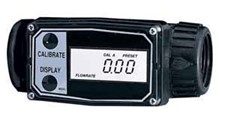Back Pressure in Flowmeters: Causes and Solutions
If you use a flowmeter to measure flow rate, you must consider the effect of back pressure. In some processes, sufficient back pressure will exceed maximum operating pressure causing some component of the process to fail. This translates to undesirable downtime and potential cost implications.
Anything connected to the flowmeter, including valves, elbows, and other structural elements, will create back pressure. In many cases, this is fine as long as the pressure generated does not exceed the maximum. For some low-pressure applications, such as an in-house air flow supply or a cylinder tank, back pressure may be minimal. For higher pressure uses in process control and research, such as in a reaction vessel pressurized system, the lines could burst from additional back pressure unless there is a relief valve. To determine what your back pressure is or will be, use a pressure gauge.

Causes of Back Pressure
- The flowmeter itself is undersized. The accuracies provided by manufacturers and suppliers are full scale. It is best not to get too close to this specified maximum when choosing a flowmeter for your process application. For example, if the accuracy is listed as 5 liters per minute and your actual flow rate is 4.9 liters per minute, this proximity to the maximum could cause pressure buildup. Selecting the appropriate flowmeter size from the start is a worthwhile investment, even if other models are more economical. Installing an undersized flowmeter will ultimately prove more costly.
- A blockage in the line produces excessive pressure. Anything that impedes the flow in the line will cause a surge in pressure, whether the blockage is from material buildup, a high level of particulates or sludge, or some other obstruction. Detecting blockages as the source of pressure changes can be challenging. Of course, removing the blockage should normalize back pressure.
- The fluid is too viscous (heat it, if possible) or the velocity is too high (increase the piping diameter/re-size the meter).
- The design of the plumbing setup. If you are experiencing consistent back pressure issues and your flowmeter is the right size for your process, it may be time to take a critical look at your setup. If elbows are positioned too close to the meter itself or to one another, back pressure will increase. Avoid creating unnecessary restrictions in the line by including a fair amount of straight runs in the setup.
Solutions to Back Pressure
While a technician could stand at the meter and manually adjust it in response to back pressure, in mass processes or large-scale production, this would not be a viable option. Here are better solutions:
- Choose the correct meter. When selecting a flowmeter, consider not just the type of meter that suits your application, but also the type of media (does it contain particulates? what is its viscosity?). Keep in mind the minimum and maximum readings of the flow range and the accuracy level you need. The pressure and temperature of the media are also variables to consider. Do not select an undersized model to save costs or an oversized model, thinking you may later maximize your output. Both choices will be less efficient and may need to be replaced for a right-sized model.
- Use a relief valve with a pressure gauge for a specific pressure (creating a bypass line). The valve will disperse some of the pressure and the gauge will indicate the level of pressure. Paired together, the combination will add stability to the line and give you more control over the pressure.
- Use a flow controller to deliver a constant flow. As its name implies, the flow controller provides more precise and consistent flow control. Some models include a large digital display with set point, flow rate, and total flow as well as programmable alarms, batch control, totalizer, and multiple set points.
- Reduce flow pressure on the inlet. For example, a tank pressure regulator will automatically stop the flow of a gas or liquid when it reaches a certain pressure threshold.
- Add another manual valve to recirculate the line and equalize the pressure.
- Use a correction factor when excessive back pressure cannot be avoided.

Guide to Various Types of Flowmeters:
| Flowmeter Type | Best Accuracy | Gas Flow Rate | Liquid Flow Rate | Max Pressure |
|---|---|---|---|---|
| Variable Area | ±2% FS | 0.1 mL/min to 2200 LP | 0.002 mL/min to 500 LPM | Typically 200 psig (varies) |
| Gas Mass | ±0.2% FS | 0.01 mL/min to 1000 LPM | ----- | Maximum 100 psig |
| Differential Pressure | ±1% FS | 0.02 mL/min to 500 LPM | 0 to 10 LPM | Maximum 100 psig |
| Pelton Wheel | ±0.5% FS | 20 mL/min to 500 LPM | 13 mL/min to 10 LPM | Maximum 500 psig |
| Turbine | ±0.5% of reading | ---- | 0.11 to 17,791 LPM | Maximum 5000 psig |
| Paddle Wheel | ±1% FS | ---- | 0.03 to 26,411 LPM | Maximum 1500 psig |
| Gear | ±0.5% of reading | ---- | 0.01 to 227 LPM | Maximum 5000 psig |
| Ultrasonic | ±0.5% of reading | ---- | Varies with pipe size | Varies with type |
| Magnetic | ≤0.3% of flow rate | ---- | 0.38 to 22,620 LPM | Maximum 259 psig |
| Coriolis | ±0.1% of flow rate | Low & high | Low & high | Maximum 580 psig |
| Vortex | ±0.75% of flow rate | 84 to 8228 LPM | Varies with density | 275 psig |